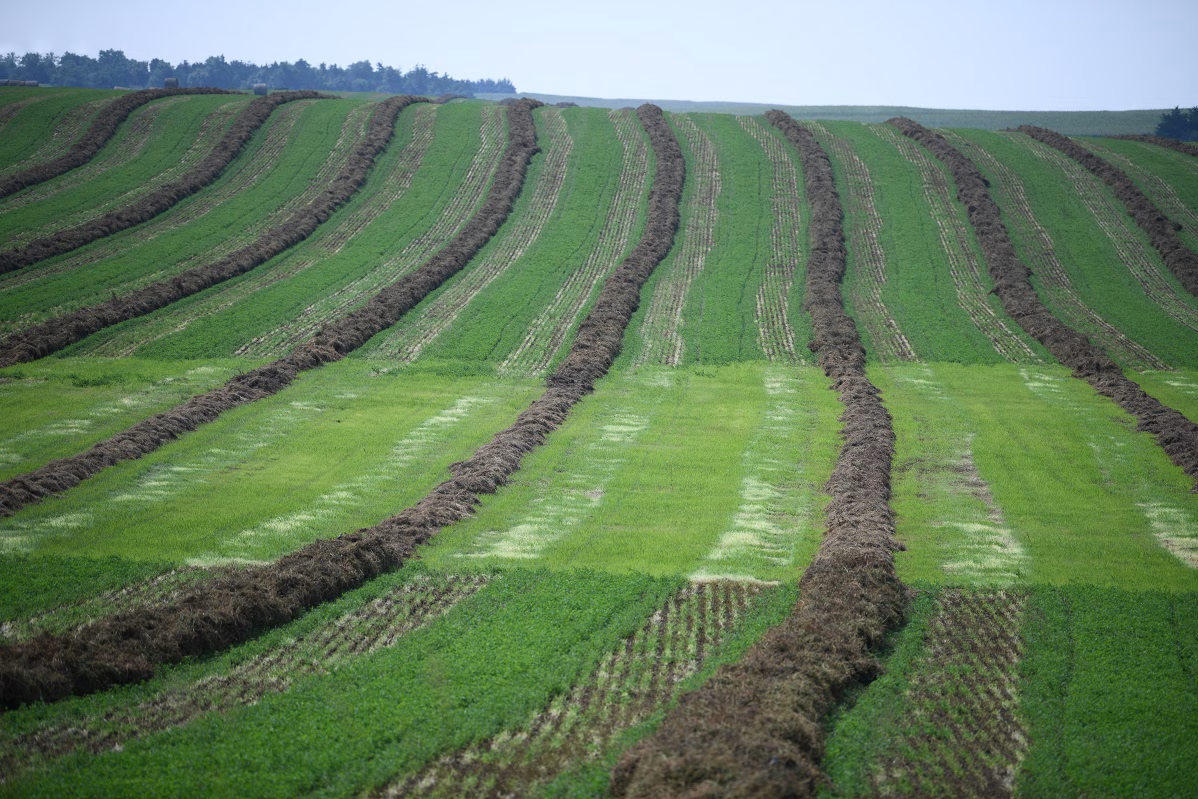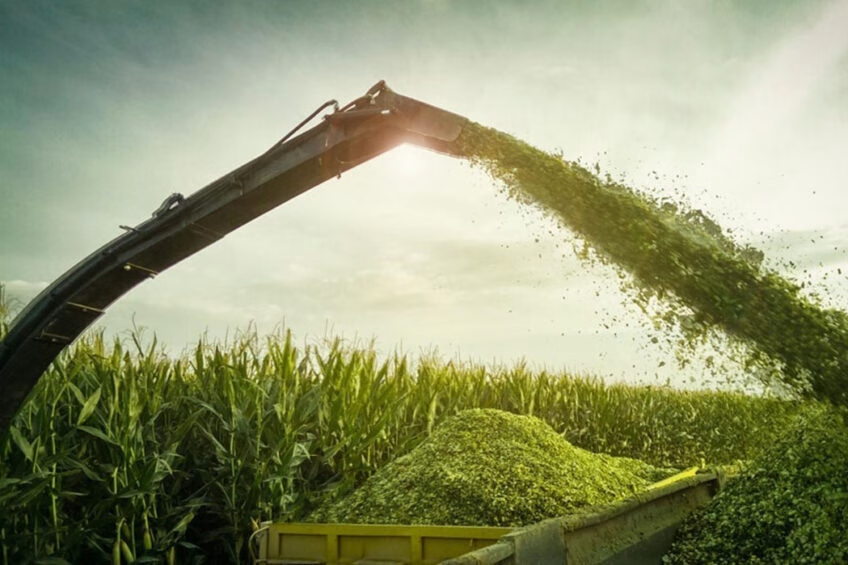Excessive rain and a poor first-cutting alfalfa crop are causing issues for farmers. Discover strategies to balance forage quality and nutrient management effectively.

The alfalfa harvest season is critical for dairy producers because it provides necessary feed for their cows. Unfortunately, this year’s first cutting has been dismal across the United States, with many farmers needing help. Heavy rainfall in southern Michigan has exacerbated the problem, resulting in a considerable decrease in forage quality. Alfalfa’s nutritional content is critical for maintaining healthy dairy cows and milk production. A bad first cut affects the season’s direction, providing issues for future farm management.
Challenges Intensified by Relentless Rain
| Year | June Rainfall (inches) |
|---|---|
| 2021 | 3.5 |
| 2022 | 4.2 |
| 2023 | 3.8 |
| 2024 | 7.1 |
Excessive rainfall, especially in southern Michigan, has undoubtedly influenced this year’s alfalfa crop. Farmers have encountered enormous hurdles, with some places receiving more than 10 inches of rain in July alone. This constant deluge has made the already tricky chore of harvesting much more daunting.
One of the biggest challenges caused by severe rainfall is the difficulty of drying and baling hay. The near-constant damp weather prohibits the requisite drying intervals for hay to be bale-ready, which usually includes allowing cut alfalfa to rest and lose moisture over many days. Instead, producers face regular interruptions from rain showers, which delay drying and impair the hay’s quality.
This prolonged precipitation causes greater humidity levels in the fodder, hindering baling. Wet hay may ferment badly or even mold, making it less nutritious and, in certain situations, unfit for cattle consumption. Thus, although the area receives enough rainfall, which keeps groundwater levels adequate, the immediate result has been a drop in fodder quality owing to the difficulty of drying and baling the hay adequately in such wet circumstances.
Delayed Harvesting and its Impact on Forage Quality
| Effect | Impact |
|---|---|
| Decreased Forage Quality | The nutritional content deteriorates as the plant matures, impacting the protein and fiber levels essential for livestock. |
| Lower Digestibility | Older alfalfa becomes tougher and less digestible, reducing its overall benefit when fed to animals. |
| Potential Yield Loss | Delayed harvesting can lead to over-mature crops, which not only affect the first-cut but also impede regrowth for subsequent cuttings. |
| Increased Weed Growth | Prolonged harvest intervals allow weeds more time to establish, competing for resources and reducing the quality of the next cut. |
| Pest Infestation | Extended time in the field increases the risk for pest infestations, which can further harm the crop quality and yield. |
This year’s unrelenting rain has considerably delayed the initial cutting of alfalfa in many fields, resulting in a noticeable decrease in fodder quality. This season’s overall quality is much lower compared to prior years when harvesting was routinely done in June. In the past, timely harvesting resulted in excellent nutrient retention and high-quality fodder. However, this year’s delayed first cut has resulted in a decline in these critical measures.
Despite these problems, some farms, especially those that cut alfalfa, have retained superior fodder quality. These facilities have consistently delivered high-quality feed by adhering to strict harvesting schedules. Consistency is vital in the dairy business, which depends significantly on nutrient-rich forages. While most fields deal with the impacts of delayed harvesting, these chopping farms have proved the value of rigorous planning and execution in maintaining feed quality.
The Yield-Quality Conundrum: Balancing Abundance and Nutrient Density
One of the most challenging decisions farmers must make is maximizing yields or preserving fodder quality. Excessive rainfall may lead to lush, green vegetation and, as a result, large yields. However, this often occurs at the price of nutritional density and digestibility. Because of delayed harvesting and high moisture, the plentiful alfalfa may have less vital elements such as protein and energy.
Farmers may require strategic feed management to handle the associated quality difficulties. Combining diverse forage cuttings becomes an important technique. Farmers may balance their feed by mixing the initial cutting, denser in volume but lower in nutrients, with successive cuttings that may have more nutritional value. This blend provides a healthy and productive diet for cattle, including dairy and meat.
As a result, although a single cutting may not offer an ideal nutritional profile, the synergistic impact of combining various phases of forage may compensate for deficits. This technique protects the livestock’s well-being and optimizes the usefulness of the whole harvest season, highlighting the need for a well-rounded and flexible feed plan in varied agricultural climates.
Nutrient Leaching: The Silent Consequence of Excessive Rainfall
Excessive rain has saturated soil moisture levels, causing many places to reach or exceed field capacity. When the soil becomes too saturated, essential elements like nitrogen, phosphate, and potassium might seep out faster than usual. This leaching process is harmful because it depletes the soil of nutrients required for healthy plant development. Furthermore, continual rainy circumstances may create anaerobic soil environments, hindering plant nutrition absorption.
Furthermore, continuous rainfall has the potential to change soil pH levels, hence influencing nutrient availability. For example, if the soil pH changes, nutrients such as boron and potassium may become less available to plants. This nutrient loss might appear as a shortage, mainly if the crops were previously deficient in essential nutrients owing to past poor fertilization methods or excessive crop removal rates. Farmers may see stunted growth, discolored foliage, or lower yields, all signs of underlying nutritional imbalances worsened by the severe rains.
Under these challenging circumstances, a proactive strategy is required, such as frequent soil testing and timely application of suitable fertilizers. Ensuring balanced nutrition profiles may help reduce some negative impacts of high moisture levels while supporting forage crop health and production.
Strategic Fertility Management: Ensuring Long-Term Productivity
Evaluating and adapting fertility programs is critical for long-term crop production, particularly in a year with high removal rates and probable nutrient depletion. Farmers must base their fertility plans on accurate crop removal rates, recognizing that higher yields equate to more nutrient extraction from the soil. Critical nutrients, such as phosphorus and potassium, must be supplemented to prevent future production decreases and deficits. Given alfalfa’s high nutritional requirements, a thorough fertility analysis is required.
Soil and tissue tests have become valuable tools for assessing nutrient requirements. Soil testing every three years allows farmers to monitor nutrient levels and make educated fertilizer selections. Tissue testing provides a more rapid assessment of plant health and nutrient absorption, allowing for prompt modifications. These procedures guarantee that fertilizer investments are targeted and efficient, resulting in healthier, more productive stands. As nutrient prices change, reducing costs to improve soil health may have long-term advantages, such as maintaining agricultural output and increasing resistance to harsh circumstances.
Strategic Nutrient Management: The Foundation of Alfalfa Vitality
Maintaining healthy alfalfa relies heavily on balancing essential nutrients, with potassium playing a critical role. Potassium helps to regulate water, activate enzymes, and fight diseases, all of which contribute to alfalfa’s robustness and winter hardiness. Phosphorus, boron, and sulfur are all essential nutrients that support plant development, nitrogen fixation, and general health.
Phosphorus is essential for root formation and energy transmission, making it especially important during alfalfa’s early growth phases. Boron is required for cell wall production and reproductive success, promoting blooming and seed development; sulfur assists in protein synthesis and chlorophyll generation, impacting yield quality and quantity.
Despite these agronomic imperatives, economic concerns significantly impact farmers’ fertilizer applications—the shifting prices of fertilizers, especially potassium and phosphorus, force farmers to strike a tight balance. High market prices often drive them to reduce treatments or depend on the soil’s residual nutrient content, thus endangering long-term soil fertility and crop yield.
Recent price trends have calmed somewhat, allowing for a strategic review. Farmers are now considering spending more on potassium treatments to restore what has been extracted from the soil. This evaluation is often driven by soil and tissue testing, which offers a more accurate picture of nutrient deficits and directs precise, cost-effective treatments.
Finally, the goal is to adopt a balanced strategy that accounts for both current costs and long-term gains. By focusing on vital nutrients and optimizing application rates, farmers may maintain healthy alfalfa stands that contribute to a resilient and productive agricultural system.
Proactive Soil Management: A Pillar of Sustained Forage Health
Producers must be diligent about soil management and fertilizer treatment throughout the forage season. Regular soil testing is an essential component of sustainable agricultural methods. Farmers may check nutrient levels by performing soil testing every three years and discover deficiencies that may limit crop health and yield. Prioritizing fields with significant shortcomings ensures that the most crucial regions get the required improvements first, maximizing resource allocation and sustaining vital forage stands.
Maintaining proper potassium levels is particularly important. Potassium increases alfalfa output while improving the plant’s winter hardiness and general health. The link between potassium adequacy and plant vigor is well-documented, making it an essential component of any fertility program. Using high-quality potash and considering additions such as boron and sulfur when deficits are discovered may help to improve plant health and nutrient absorption.
Depending on in-season observations and continuous soil test findings, you must adjust your strategy as the season develops. This adaptive management will assist in offsetting the effects of unpredictable weather patterns and guarantee that your forage crops are robust and productive throughout their growing season. Taking these actions helps promote immediate agricultural outputs while contributing to your farm’s long-term sustainability and production.
The Bottom Line
Despite a problematic wet season, careful management strategies may assure success in alfalfa production. Although this year’s initial cutting may not be optimum, effective fertilizer management and adaptive tactics may lead to better future harvests. Understand the effect of rain, strike a balance between production and quality, and implement proactive soil and fertility management. To limit the danger of leaching, provide an appropriate supply of potassium and nutrients. Regular soil testing and targeted fertilizing are essential for healthy alfalfa stands. Manage weather difficulties and fertility concerns effectively to ensure high yields and quality forage. For long-term alfalfa production, implement rigorous fertilization programs and monitor soil health.
Key Takeaways:
- Excessive rainfall has severely impacted the first-cutting quality of alfalfa, with some farmers still trying to complete it.
- Regions like southern Michigan have experienced over 10 inches of rain in July alone, complicating the drying and baling process for hay.
- Despite abundant moisture, the quality of the forage has decreased, affecting nutrient content and necessitating balanced feeding strategies for livestock.
- Heavy rain has led to nutrient leaching, particularly of potassium and phosphorus, putting additional strain on soil fertility.
- Farmers are advised to conduct soil tests every three years to identify deficiencies and prioritize fertilizer application accordingly.
- Maintaining adequate potassium levels is crucial for ensuring healthy and productive alfalfa stands, particularly for winter hardiness.
Summary:
The alfalfa harvest season is crucial for dairy producers as it provides necessary feed for their cows. However, this year’s first cutting has been dismal, with heavy rainfall in southern Michigan causing a significant decrease in forage quality. The nutritional content of alfalfa is crucial for maintaining healthy dairy cows and milk production. The delayed harvesting and impact on fodder quality have led to a noticeable decrease in overall quality. Farmers must make strategic feed management to handle these difficulties, combining diverse forage cuttings to provide a healthy and productive diet for cattle, including dairy and meat. Strategic Fertility Management is crucial for long-term crop production, especially in a year with high removal rates and probable nutrient depletion. Soil and tissue tests have become valuable tools for assessing nutrient requirements, allowing farmers to make educated fertilizer selections.












